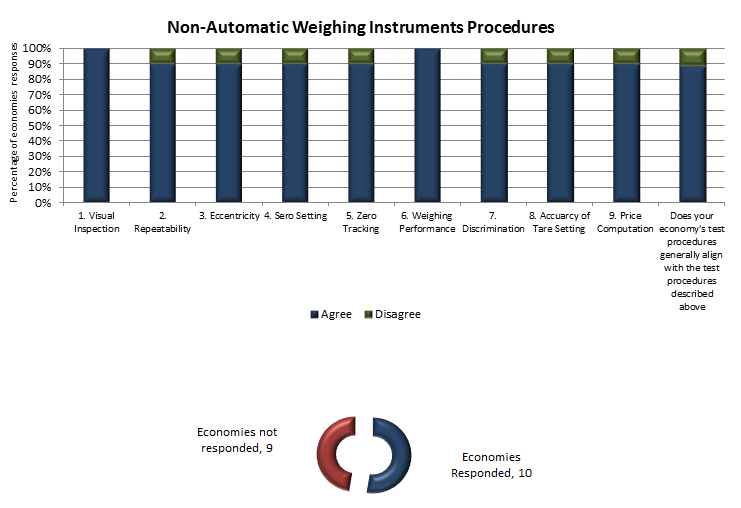Non-automatic weighing instruments
In 2015 APLMF agreed to summarise the test procedures used in each APLMF training course and then to survey its members to validate the test procedures and to provide some quality control. The validated test procedures will be later used to develop eLearning modules.
The summary test procedures are provided to guide economies wishing to follow OIML recommendations. They contain abbreviated terms and formulae which are defined in the relevant OIML recommendation.
Information relating to Non-Automatic Weighing Instruments:
The summary test procedures are provided to guide economies wishing to follow OIML recommendations. They contain abbreviated terms and formulae which are defined in the relevant OIML recommendation.
Information relating to Non-Automatic Weighing Instruments:
SUMMARY OF TEST PROCEDURES USED TO VERIFY NON-AUTOMATIC WEIGHING INSTRUMENTS
- These test procedures are based on OIML R76.
- Please note tests used to compile this summary are fully described in the documents NITP 6.1 to 6.4 NITPs for Non-automatic Weighing Instruments on the National Measurement Institute Australia website.
Test Name |
Procedures Description |
VISUAL INSPECTION |
|
REPEATABILITY |
|
ECCENTRICITY |
|
ZERO SETTING Only performed at initial verification, when system changes affect these functions (Non-automatic and semi-automatic only) |
|
ZERO TRACKING Only performed at initial verification, when system changes affect these functions (Non-automatic and semi-automatic only) |
|
WEIGHING PERFORMANCE |
|
DISCRIMINATION |
|
ACCURACY OF TARE SETTING Only performed at initial verification, when system changes affect these functions (Non-automatic and semi-automatic only) |
|
PRICE-COMPUTATION Only performed at initial verification, when system changes affect these functions (Non-automatic and semi-automatic only) |
|
SUMMARY OF ECONOMY REPORTS
Verification of NAWI training 28 November to 1 December 2016.
Economy |
Legislation |
SI |
MPE used |
Inspector or 3rd party |
Verification periods |
Bangladesh |
Yes |
Yes |
Not set yet |
Inspectors |
Yes in legislation |
Bhutan |
Yes |
Yes |
As per R76 |
Inspectors |
Yes, 6 months or 1 year |
Cambodia |
Yes |
Yes |
As per R76 |
Inspectors |
1year |
Fiji |
Yes |
Yes |
As per R76 |
Inspectors |
- |
Malaysia |
Yes |
Yes |
As per R76 |
3rd Party (Metrology Corporation) |
1 Year |
Mongolia |
Yes |
Yes |
As per R76 |
Inspectors |
- |
Nepal |
Yes |
Yes |
As per R76 |
Inspectors |
- |
Papua New Guinea |
Yes |
Yes |
As per R76 |
Inspectors |
- |
Philippines |
Yes |
Yes |
As per R76 |
Inspectors |
- |
Sri Lanka |
Yes |
Yes |
As per R76 |
Inspectors |
1 Year |
Thailand |
Yes |
Yes |
As per R76 |
Inspectors |
- |
Uzbekistan |
Yes |
Yes |
As per R76 |
Inspectors |
1 Year |
Vietnam |
Yes |
Yes |
As per R76 |
Inspectors |
- |
Economy |
OIML compliant |
Type approval |
Issues |
Other |
Bangladesh |
Some what |
No |
More equipment and knowledge |
- |
Bhutan |
Yes |
No |
- |
- |
Cambodia |
Yes |
No |
No facilities for PA Lack of experts Limited budget Limited standards |
- |
Fiji |
Yes |
Yes |
Budget – standards Lack of investment Need technical assistance |
- |
Malaysia |
Yes |
Yes |
Software verification |
- |
Mongolia |
- |
Yes |
- |
- |
Nepal |
- |
Yes |
Lack of trained manpower Act 40 y old Low penalty for fraud |
- |
Papua New Guinea |
- |
No |
- |
- |
Philippines |
Yes |
No |
National Metrology Board not convened Lack of technical guidelines |
No digital verification Lots of work |
Sri Lanka |
Yes |
Yes |
District but no divisional inspectors Need more staff Consumer education |
- |
Thailand |
Yes |
No |
- |
- |
Uzbekistan |
Yes |
Yes |
- |
- |
Vietnam |
Yes |
No |
- |
- |
SURVEY RESULTS ON ADOPTING THE NON-AUTOMATIC WEIGHING INSTRUMENTS TEST PROCEDURES
The following results are from a survey completed in 2016.
Test name |
Total economies surveyed |
Agree |
Disagree |
Economies not responded |
1. Visual Inspection |
19 |
10 |
1 |
9 |
2. Repeatability |
19 |
9 |
1 |
9 |
3. Eccentricity |
19 |
9 |
1 |
9 |
4. Zero Setting |
19 |
9 |
1 |
9 |
5. Zero Tracking |
19 |
9 |
1 |
9 |
6. Weighing Performance |
19 |
10 |
Value |
9 |
7. Discrimination |
19 |
9 |
1 |
9 |
8. Accuarcy of Tare Setting |
19 |
9 |
1 |
9 |
9. Price Computation |
19 |
9 |
1 |
9 |
Does your economy's test procedures generally align with the test procedures described above |
19 |
8 |
1 |
10 |
Economies who responded:
Australia, Cambodia, Canada, Japan, New Zealand, Papua New Guinea, Philippines, Singapore, Chinese Taipei, Vietnam
Australia, Cambodia, Canada, Japan, New Zealand, Papua New Guinea, Philippines, Singapore, Chinese Taipei, Vietnam

